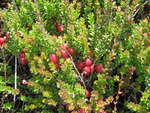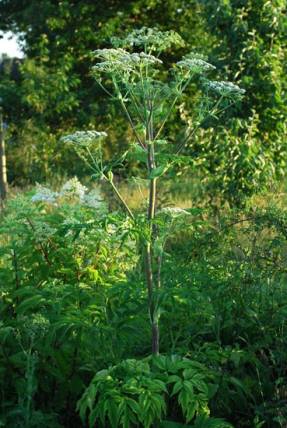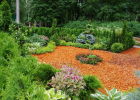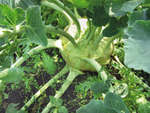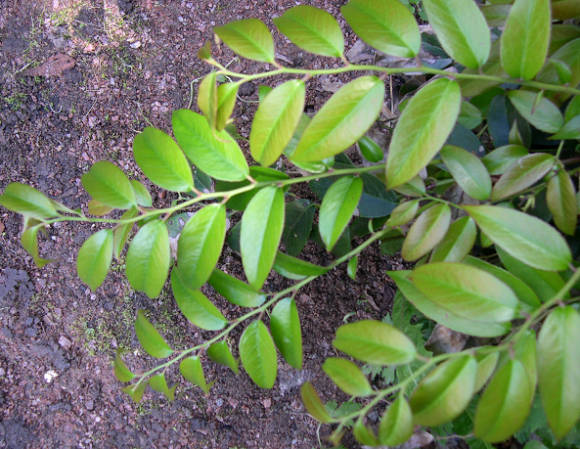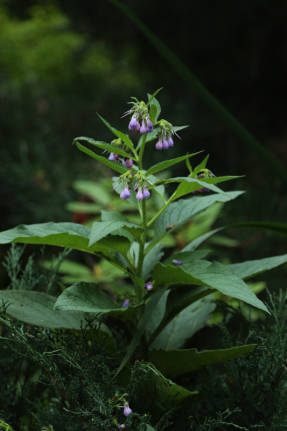 Genus comfrey (Symphytum) from the Borage family, there are 19 species, and in addition, interspecific hybrids have been described. First of all, this is comfrey, which is mentioned in all books on herbal medicine (S. officinalis), then a very powerful rough comfrey (S. asperum Lepech.), And quite small comfrey tuberous (S. tuberosum L.). In the Caucasus, there are comfrey foreign (S. peregrinum Ledeb.) And comfrey Caucasian (S. caucasicus Bieb.). In addition, it is also mentioned that it grows in Europe and the USA. comfrey russian (S. x uplandicum). However, in this case, the botanists disagree. Some equate it with foreign comfrey, and some consider it a hybrid of medicinal and rough comfrey. But we'd better leave this problem to the taxonomists.
Genus comfrey (Symphytum) from the Borage family, there are 19 species, and in addition, interspecific hybrids have been described. First of all, this is comfrey, which is mentioned in all books on herbal medicine (S. officinalis), then a very powerful rough comfrey (S. asperum Lepech.), And quite small comfrey tuberous (S. tuberosum L.). In the Caucasus, there are comfrey foreign (S. peregrinum Ledeb.) And comfrey Caucasian (S. caucasicus Bieb.). In addition, it is also mentioned that it grows in Europe and the USA. comfrey russian (S. x uplandicum). However, in this case, the botanists disagree. Some equate it with foreign comfrey, and some consider it a hybrid of medicinal and rough comfrey. But we'd better leave this problem to the taxonomists. They are almost the same in chemical composition and therefore, talking about medicinal properties, we will call them the general word comfrey. Although there are some differences - some species lack individual alkaloids. And comfrey rough and medicinal are very close.
Latin name Symphytum comes from Greek "Symphyeiln" - to grow together, which indicates its traditional use for bone healing in fractures. Since the time of Dioscorides, it has been used as a wound healing agent and for abscesses.
The aboveground mass of comfrey medicinal contains up to 0.2% pyrrolizidine alkaloids (echimidine, symphitin, cinoglossin), glycoalkoloid consolididin, tannins, mucus, choline, traces of essential oil. Both the aboveground mass and the roots contain a large amount of vitamin B12, its amount is comparable to that of meat and eggs and 4 times more than in yeast! Also low in fiber, it is readily eaten by pets. And, according to some studies, it is the high content of this vitamin that neutralizes the harmful pyrrolizidine alkaloids in the "animal stomachs". It also contains a lot of potassium - almost three times more than in other plants. The herb in folk medicine of Central European countries was used for lung diseases. Now, due to the content of pyrrolizidine alkaloids, they are practically not used.

The root contains allantoin (0.6-0.8%), tannins and mucous substances (fructans), asparagine, triterpene saponins (primarily symphytoxide A), rosmarinic acid, silicon compounds, phytosterol and all the same pyrrolizidine alkaloids (0.3 -0.4%), which should be discussed in more detail. In addition, a new glycoprotein was isolated, which has an anti-inflammatory effect and is of great importance.
Allantoin is a fairly common compound in the plant world, which is also abundant in legumes. Scientists attribute this to the fact that bacteria living on the roots are involved in its formation, and in the form of allantoin, nitrogen simply moves in the plant to those places where it is needed for the growth and formation of proteins, nucleic acids, etc. Experiments with labeled nitrogen confirmed this. When bacteria were removed, the content of this substance in soy was found to be negligible. Comfrey also has a lot of "soil friends" and, probably, the high content of this compound has the same cause as in legumes.
Allantoin promotes tissue granulation and regeneration, as well as bone fusion. It has specific osmotic properties - fluid is released through the surface of the wound, washing out bacteria and their waste products. The formation of new cells is enhanced. Choline helps to improve local blood circulation and faster resorption of hematoma. The present rosmarinic acid has anti-inflammatory, analgesic and antioxidant effects. Saponin oxide A demonstrates antimicrobial activity.
Previously, comfrey was used for gastritis and even stomach ulcers inside in the form of a decoction, but now they are limited to external use. Although many European cookbooks recommend its young leaves for salads and as a nutritious spinach substitute. In general, the people's experience diverged from science.
A bit of horror

Allantoin and its aluminum salt (aluminum hydroxide allantoinate) isolated from the roots of the comfrey are non-toxic compounds.The toxic effect of comfrey on the body of animals and humans is due to the content of pyrrolizidine alkaloids in it, in particular, cinoglossine, consolidin and laziocarpine, which can cause paralysis of the central nervous system, since they cause a partial blockade of the ganglia, disrupting the conduction of impulses to the striated muscles.
In 1992, suddenly there was a problem with pyrrolizidine alkaloids. Germany has published extremely strict restrictive standards for this group of compounds due to their carcinogenic and toxic effects, which they showed in animal studies. Contained in the roots of comfrey, as well as in the seeds of heliotrope pubescent (Heliotropium lasiocarpium L.) alkaloid laziocarpine is a fairly toxic compound. Because of this alkaloid and heliotrope seeds containing it, which got into the grain, the inhabitants of Central Asia in 1931-1945. toxic hepatitis was common.
Pyrrolizidine alkaloids are carcinogenic. The ability of comfrey to induce the development of liver cancer in experimental animals is associated with simfitin. In addition, the alkaloids laziocarpine and cinoglossin are capable of causing mutations in the body.
The alkaloid laziocarpine in its pure form at a dose of 50 ppm / per 1 kg of body weight causes liver cancer in experimental rodents. Toxicological studies indicate that the addition of 0.5% roots and 8% comfrey leaves to the food of rats causes the development of malignant tumors of the liver and bladder. But at the same time, it should be remembered that there is very little of it in the comfrey and it does not enter the body in its pure form.
Many previously used plants containing these substances were blacklisted, for example, in Germany ... mother and stepmother were banned.
Medicinal uses of comfrey

Despite the dangers described above, in Germany, for example, there is a huge amount of comfrey preparations. Its effectiveness has been confirmed by serious clinical trials. In the formulations of a number of drugs, some changes were simply made (Rectosan, Digestosan, Neopectosan) and the internal use of comfrey drugs was limited.
Only medicinal preparations from comfrey for external use, dental and cosmetic products are allowed for use. Due to teratogenic properties, comfrey preparations should not be used during pregnancy and lactation. Comfrey preparations in Germany are recommended to be used no more than 4-6 weeks per year.
But, as indicated by some literary sources, comfrey roots contain a small amount of pyrrolizidine alkaloids, and they are not a typical alkaloid-containing raw material. Therefore, the remedies from the roots cannot lead to the above-mentioned toxic manifestations in the body. Despite the significant toxicity of individual comfrey alkaloids, in the scientific and practical literature, we have not found any publications on the lethal toxicity of galenic or novogalenic agents made on the basis of comfrey roots or grass. Rather, a couple of dubious examples wander from one source to another. In general, it seems that this problem is greatly exaggerated. After all, alkaloids were tested in their pure form, and in the plant they are contained with polysaccharides and other substances. But someone has not canceled his strong hemostatic and wound healing effect in case of ulcers and tuberculosis.
In modern medical practice, comfrey medicinal products are used in clinical dentistry due to their ability to stimulate and regenerate periodontal cells. Positive results were obtained with the use of comfrey for periodontal disease, including the purulent form. For this purpose, rinsing of the mouth with a decoction of comfrey roots was prescribed. The combination of comfrey with other plants, such as basil herb and linden blossom, is very popular, which significantly enhances the anti-inflammatory and antimicrobial effect.
For example, a Bulgarian drug for the treatment of this disease is a decoction of comfrey roots, St. John's wort herb, bearberry leaf, dioecious nettle root leaf and soapwort roots. Antiseptics were added to the finished broth: metronidazole, collargol and sodium benzoate. Such a combined decoction in the experiment showed a pronounced anti-inflammatory effect and a positive effect in 78% of patients with periodontal disease. But you can make a decoction at home without chemical ingredients, it will also be quite effective.
Based on allantoin in combination with aluminum fluoride, aluminum lactate, chlorhexidine, bisabolol and peppermint essential oil, well-known pharmaceutical companies produce gum rinses.
In Romania, a patented ointment with anti-inflammatory, keratolytic and epithelizing properties for the treatment of psoriasis, which contains allantoin. In cosmetics, this substance fights acne. Clinical observation data indicate a high therapeutic effect of the use of ointment from comfrey roots for annular granuloma, vasculitis, focal scleroderma, trophic ulcers, cracks in the corners of the mouth.
Comfrey has been widely used in homeopathy for over 100 years. Comfrey was introduced to homeopathy based on the knowledge of traditional medicine. As a homeopathic remedy, comfrey was first partially tested by McFerlan, who first used it as a poultice as a wound healing agent. Later, Grosserio began to use Symphytum in 30-fold dilution for bone injuries, primarily fractures. Currently, its use has expanded, and modern homeopaths prescribe it not only for bone fractures, but also for paralysis, caries, gastric ulcer and duodenal ulcer and hemorrhoids.
How to use comfrey at home
There are a lot of recipes: from the usual decoction to ointments and suppositories. Here's one of the options. Take fresh comfrey root, grate or grind in a meat grinder, sprinkle with corn oil, stir. This mass in the form of a compress is applied to sore veins, burns, wounds, sore joints and ligaments, bruises and bruises. In winter, you can take the powder of dry roots, add a little water to make a gruel, again add a few drops of oil and use as described above.
Decoction prepared from 10 g of chopped roots and a glass of water. Boil for 10 minutes, filter and use for compresses.
If you are a fan of aromatherapy, add a few drops of pine and lavender oil to the crushed comfrey roots. Oils complement the action of comfrey, in addition, they exhibit a very strong antimicrobial effect. Lavender was even used in World War I to prevent gangrene. Apply the resulting gruel to a sore spot with sprains, hematomas and other traumatic injuries. The same oils can be added to the comfrey root ointment.
A ointment prepare as follows: mix 10 g of comfrey roots chopped in a meat grinder with 100 g of interior lard or an ointment base. Put this mixture in a water bath for 2-3 hours. After that, while hot, strain through a cloth and store in the refrigerator in a jar. Apply as described above.
Among other things, comfrey ointment is good at stopping nosebleeds.
For the courtyard

In Soviet times, comfrey was one of the promising new forage crops designed to raise livestock production. The protein content in it is almost the same as in alfalfa, and only 2 times less than in soybeans, including all the essential amino acids that are free from protease inhibitors. And given that he has several mows during the summer, the protein yield per unit area is higher than that of soybeans.In addition, rough comfrey, for example, is a very powerful perennial plant, which weeds cannot withstand. It grows in partial shade, where other crops simply do not grow. And what is interesting, despite the presence of pyrolizidine alkaloids, which German pharmacologists fear, toxic hepatitis and other "pyrrolizidine" charms are not found in them.
In addition, comfrey is sometimes referred to as "green manure". Due to the high content of nitrogen and potassium, it is nutritionally comparable to cow dung. But if you do decide to grow this plant, find a shaded place for it somewhere away from flower beds and other cultivated plants. It becomes a vicious weed with a very deep root, and its behavior resembles spreading horseradish over a plot.
Comfrey is also a wonderful honey plant: hard comfrey gives 101.5-227.1 kg / ha of honey, Caucasian comfrey - 114.5-205.0, foreign comfrey - 116.6-127.5 medicinal comfrey - 79.6- 181.2 kg / ha, and this is also with a fairly long flowering.
You can sow it with seeds or transplant the root. Then self-seeding is already abundantly formed - try to remove it in time from places not intended for it.

